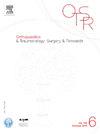关节镜检测髌骨上胫骨内钉软骨损伤:发生率、程度和临床相关性。一项前瞻性研究。
IF 2.2
3区 医学
Q2 ORTHOPEDICS
引用次数: 0
摘要
背景:髌上髓内钉(SP-IMN)由于其生物力学和临床优势而被广泛应用于胫骨干骨折。然而,由于前瞻性研究的证据有限,人们仍然担心潜在的软骨损伤。本研究旨在通过评估软骨损伤的发生率、碎片的存在及其对临床结果的影响来解决这些空白。具体来说,我们试图回答以下问题:(1)临床结果是否因软骨损伤的不同位置或等级而不同?(2) SP-IMN术后软骨损伤的发生率是多少?(3)软骨损伤有哪些特点?假设:我们假设软骨损伤的程度和解剖位置可能影响临床结果,更严重或广泛分布的损伤可能导致较差的临床结果。患者和方法:这项前瞻性研究包括51例使用SP-IMN治疗胫骨干骨折的患者。关节镜评估在钉前和钉后评估软骨损伤。采用Outerbridge分级对软骨损伤进行分级。采用Lysholm评分、视觉模拟评分(VAS)评分、前路负重测试(AWT-K)比和关节活动度(ROM)对术后3、6和12个月的临床结果进行评估。结果:70%的病例出现软骨损伤,其中最常见的是Outerbridge 1级损伤(35%)。57%的病例发现金属碎片,主要局限于Hoffa脂肪垫。软骨损伤和金属碎片都没有显著影响临床结果,包括Lysholm评分、VAS评分、AWT-K比或ROM。随着时间的推移,所有患者的这些临床指标都有显著改善,而不考虑关节内的发现。结论:SP-IMN是治疗胫骨干骨折的有效技术,软骨损伤和金属碎片发生率高,但对临床结果无明显不良影响。需要进一步研究金属碎片的长期影响,并改进手术技术以尽量减少关节内损伤。证据等级:III:单队列前瞻性研究。本文章由计算机程序翻译,如有差异,请以英文原文为准。
Arthroscopic Detection of Chondral Damage in Suprapatellar Tibia Nailing: Incidence, Extent, and Clinical Relevance. A prospective study
Background
Suprapatellar intramedullary nailing (SP-IMN) is widely used for tibial shaft fractures due to its biomechanical and clinical advantages over infrapatellar approaches. However, concerns remain regarding potential chondral damage, with limited evidence from prospective studies. This study aims to address these gaps by evaluating the incidence of chondral damage, the presence of debris, and their effects on clinical outcomes. Specifically, we sought to answer the following questions: (1) Do clinical outcomes differ with different locations or grades of chondral damage? (2) What is the incidence of chondral damage following SP-IMN? (3) What are the characteristics of chondral damage?
Hypothesis
We hypothesize that extent and anatomical location of chondral damage may influence clinical outcomes, with more severe or widely distributed injuries potentially leading to poorer clinical results.
Patients and methods
This prospective study included 51 patients treated with SP-IMN for tibial shaft fractures. Arthroscopic evaluations were performed pre- and post nailing to assess chondral damage. The Outerbridge classification was used to grade chondral injuries. Clinical outcomes were assessed at 3, 6, and 12 months postoperatively using Lysholm scores, Visual Analog Scale (VAS) scores, anterior weight-bearing test (AWT-K) ratio, and range of motion (ROM).
Results
Chondral damage was observed in 70% of cases, with Outerbridge Grade 1 injuries being the most common (35%). Metallic debris was identified in 57% of cases, predominantly localized in Hoffa’s fat pad. Neither chondral damage nor metallic debris significantly affected clinical outcomes, including Lysholm scores, VAS scores, AWT-K ratio, or ROM. Significant improvements in these clinical measures were observed over time for all patients, irrespective of intra-articular findings.
Conclusion
SP-IMN is an effective technique for tibial shaft fractures, with a high incidence of chondral damage and metallic debris but no significant adverse impact on clinical outcomes. Further studies are warranted to explore the long-term effects of metallic debris and refine surgical techniques to minimize intra-articular injuries.
Level of evidence III
Single cohort prospective study.
求助全文
通过发布文献求助,成功后即可免费获取论文全文。
去求助
来源期刊
CiteScore
5.10
自引率
26.10%
发文量
329
审稿时长
12.5 weeks
期刊介绍:
Orthopaedics & Traumatology: Surgery & Research (OTSR) publishes original scientific work in English related to all domains of orthopaedics. Original articles, Reviews, Technical notes and Concise follow-up of a former OTSR study are published in English in electronic form only and indexed in the main international databases.

 求助内容:
求助内容: 应助结果提醒方式:
应助结果提醒方式:


